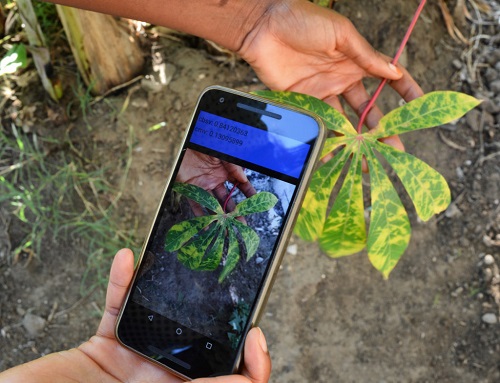
It is quite clear that globally agriculture plays a significant part in the economic subdivision. But, mechanization in agriculture should be the main concern and the emerging subject across the globe. Because, as population increases,the demand of food and employment also increases.
Thus, traditionalapproaches which were used by the agriculturalists were not adequate enough to fulfill food requirements. New automated mechanism have been introduced. These new methods are expected to satisfythe food requirements and provide employment opportunities to billions of people indeed .
Above all, professionals in the field saythat Artificial Intelligence’s (AI’s) contribution in agriculture has brought an agriculture revolution. The technology has protected the crop yield from various factors like the climate changes, population growth, employment issues and the food security problems. Various applications of AIin agriculture such as for irrigation, weeding, spraying with the help of sensors and other means embedded in robots and drones.
Furthermore,these technologies could save the excess use of water, pesticides, herbicides, maintains the fertility of the soil, also help in the efficient use of man power and elevate the productivity and improve the quality, they said.
Dr.YemisrachMelkie a researcher said that AI contributes to solve agricultural productivity in Ethiopian context . As most of us know that agriculture plays a central role in life and livelihood of our country . It isthe backbone of our economy . Contributing around 45 percent of the GDP, It generates 85 percent of the foreign currency revenue. And it also covers 83 percent of the population employment of the country.
Agriculture is considered as one of the major sector of our country, especially for the country’s GDP contribution . Almost 100 percent of export commodities are generated from agriculture.Thus , crops have integrated influence of agricultures.
Meaningfully,crop production has a historical background in Ethiopia. The country produces different crop types like cereals, pulses, oil crops , vegetables. Importantly cereals’ share is around 70 percentof the country’s crop production. For the last two decades, agricultural productivity trends have been increasing .But when compared with globally ,it still remains less. It’s very low; around 2. 3 per / hectare but the world average is four. Ethiopia’s is lower than the world average byaround 50 percent .
Besides,the country facesa lot of challenges in crop production, especially incereal crops and pulse production. Pests and diseases arethe major challenges of crop production and productivity. Deforestation and soil degradation, lack of improved technology, post-harvest lost, erratic weather are the key challenges in the country. However, even if we have various challenges, the sector has a lot of opportunities.
The country has a lot of natural resources , specially irrigation potential, biodiversity and diverse agro- ecologies.However, disease and pest are a historical challenge for the global crop production. For instance,Irish farming due to late potato disease in 1845 , Bengal farming due to brown spot of rice in India around 1942 , and coffee rust in Seri lank in 1967 are some of tests. Even currently , there are a lot of challenges because of the crop diseases and pests around the world .
Therefore ,fighting diseases and pests are really a critical point for our agriculture. A study conducted by Nature of Ecology and Evolution in 2019 about the global burden of pathogen and pests on major food crops said that it had identified 137 pathogens and pests in five major food crops. This study also indicated that there are high lose associated with the cause of food insufficient region in developing countries like Ethiopia.
The major diseases in Ethiopia , especially in wheat , stem rust, yellow and leaf rust are diseases which affect wheat production. The country can lose up to 100 percent of the crop. Ethiopia can also lose 11 percent in Teff and 100 percent in barley due to the diseases. This means diseases may have 100 percent potential to lose all crops. Pulse is also the second major crop in Ethiopia, but there will be a potential end lose because of diseases.
Moreover, erratic weather is also another challenge in the country. Mostly weather plays major role in crop production . Ethiopia is considered as one of vulnerabl ecountry because of climate change . Specially, rain fall has a significant roles the livelihood of our farmers . However this rain has erratic pattern. For the last three decades the country has been suffering from rainy and the other is drought season So technology has the potential to predict weathers and contribute in facilitating the farmers efficiency based on weather prediction .Thus AI has the potential to contribute and eradicate this challenge.
Another challenge is post-harvest challenge. Post harvest lose is one of the concern in poverty reduction in many developing countries , especially in African countries,post harvest lose is critical in crop production, particularly in oil crops and fruits . The country loses yields because of post harvest lose reasons.
AI has great contribution in easingcrop production challenges, by pest and disease detection, monitoring agronomy practice. It also helps weather prediction But the country can reduce disease causes by chemical use and by improving harvest quality and increasing labor efficiency, she said .
Current plant disease detection experience; there is a lot of disease detection experience efficiency in all fields and also manage the challenges faced by various industries including the various fields in the agricultural sector like the crop yield, irrigation, soil content sensing, crop- monitoring, weeding among others .
According to scholars, the technologies which are AI-based help to improve productivity of crops. Agricultural robots are built in order to deliver high valued application of AI in the mentioned sector. With the global population rising, the agricultural sector is facing a crisis, but AI has the potential to deliver much-needed solution. AI- based technological solutions has enabled the farmers to produce more output with less input and even improved the quality of output, also ensuring faster go-to- market for the yielded crops.
AIresearchers say that it is a wide-ranging branch of computer science concerned with building smart machines capable of performing tasks that typically require human intelligence. AI is an interdisciplinary science with multiple approaches, but advancements in machine learning and deep learning are creating a paradigm shift in virtually every sector of the tech industry.
BY ALAZAR SHIFERAW
The Ethiopian Herald June 11/2021





